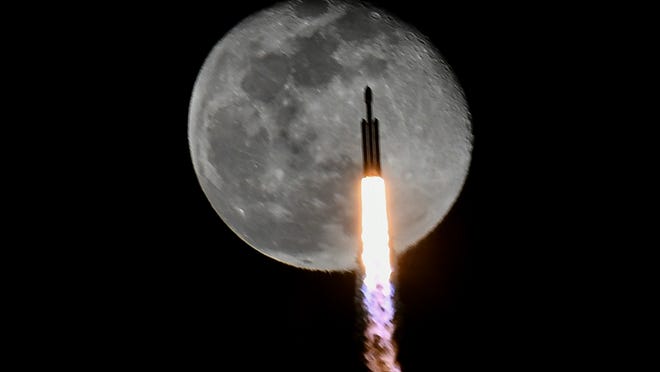It’s time to bring out the big engines. Those on the Space Coast will soon be in for a treat.
Not one, but three Falcon 9 first stage rockets making up the Falcon Heavy are tentatively scheduled to blast into the Florida sky in tandem this week to carry a weather satellite into orbit.
It’s been awhile since Florida has seen this sight: two Falcon 9s supporting the main rocket tasked with carrying the second stage and payload into space. Falcon Heavy last rose into the Florida sky in late December from Kennedy Space Center’s Pad 39A, carrying the secret Space Forcespaceplane known as X-37B. The only other comparable launch since then was the triple-core ULA Delta IV Heavy finale, which carried a payload for the National Reconnaissance Office back in April from Cape Canaveral.
Why is Falcon Heavy needed for this launch?
A bigger payload demands more power, and with NOAA and NASA ready to launch the GOES-U weather satellite as soon as Tuesday, June 25, they needed a bigger rocket. The satellite is comparable in size to a small school bus so one of the heaviest lift rockets will be utilized. Enter the Falcon Heavy.
When is the next Florida launch?Is there a launch today? Upcoming SpaceX, NASA, ULA rocket launch schedule in Florida
SpaceX Space Coast rockets: Falcon Heavy vs Falcon 9
Simply put, the Falcon Heavy is three Falcon 9 rocket first stages — which together give three times the lift. The center Falcon 9 is fully loaded with the second stage of the rocket and the payload atop. The payload, in this case the NOAA satellite, is encased in fairings to shield it on the way to space.
By comparison, the Falcon 9 that launches Starlink missions is a single rocket. Just one of these single rockets towers 229.6 ft tall with the second stage and has a diameter of 12 ft.
With three of these Falcon 9 rockets, the monster Falcon Heavy stands the same height. However, it’s much wider, giving it a width of 39.9 ft, which is comparable to almost three cars parked bumper to bumper.

According to SpaceX, the Falcon Heavy has flown nine launches, 17 booster landings, and 14 booster reflights.
The first successful Falcon Heavy took to the skies in February of 2018, carrying as its payload a red Tesla Roadster, along with a mannequin dubbed ‘Starman‘ − which was adorned in a SpaceX spacesuit.
Falcon Heavy thrust: how powerful is this rocket?
Three Falcon 9 rockets – each having nine Merlin engines of power —gives the Falcon Heavy vehicle the power of 27 Merlin engines at liftoff. Each of these 27 engines provides 190,000 lbs of thrust. According to SpaceX, this power provides more five-million pounds of thrust in total.
SpaceX says the Falcon Heavy can lift the weight comparable to a 737 jetliner, along with all its fuel, cargo, passengers, and get that weight into orbit.
Space X Falcon Heavy booster landing
SpaceX will recover the two supporting Falcon 9 boosters. If they follow the procedure of previous flights, the two boosters will land at the Cape Canaveral landing site – giving off a double sonic boom. Should SpaceX continue with the routine of past Falcon Heavy flights, the core Falcon 9 will break up over the ocean after it completes its task.
Landing all three boosters has proven to be a difficult task. While a core booster landed on a droneship in the Atlantic in 2019, SpaceX was unsuccessful in bringing it back to port.
Get ready for Falcon Heavy sonic booms
As the two supporting boosters land at SpaceX landing sites 1 and 2 on the coast of Cape Canaveral, two sonic booms will be heard on the Space Coast. As the boosters fall back to Earth, they travel faster than the speed of sound. This in turn breaks the sound barrier, letting off a noise comparable to a loud clap of thunder.
The sonic booms will come as the boosters are already landing, which may seem puzzling. Physics simply explains this situation as light travels faster than sound. The returning boosters will be seen before the sonic booms are heard.
It can be a startling sight, especially if one has never witnessed it − the boosters appear to land silently before a loud, Earth-shaking sound is heard.
When is SpaceX Falcon Heavy launching
On Tuesday, if weather on the Space Coast permits, the Falcon Heavy will blast off from Kennedy Space Center’s Pad 39A, ferrying the NOAA/NASA GOES-U satellite into orbit.
GOES-U is NOAA’s latest weather satellite, which promises continuing hurricane tracking. Weather observation satellites, such as the GOES series, are important to locations which experience these extreme weather phenomena − such as Florida.

GOES-U will provide a valuable watch from above − observing hurricanes as they form. “We know about them because of the GOES satellites. They sit above the equator about 22,000 miles above the Earth and keep a constant watch,” Dan Lindsey, a NOAA program scientist, told FLORIDA TODAY.
Be sure to follow the FLORIDA TODAY Space Team for the latest updates from the Space Coast.
Brooke Edwards is a Space Reporter for Florida Today. Contact her at bedwards@floridatoday.com or on X: @brookeofstars.
#SpaceX #Falcon #Heavy #launch #NOAA #satellite,
#SpaceX #Falcon #Heavy #launch #NOAA #satellite

